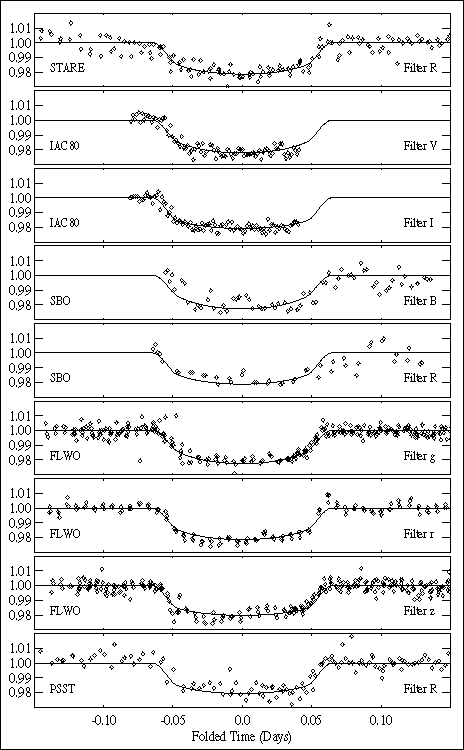[Discovery of Planet] [Detection of Thermal Emission] [Main Page]
Download preprint accepted by Astrophysical Journal Letters, 23 August, 2004 (163Kb PDF file).
Go to NCAR Press Release.

[Discovery of Planet] [Detection of Thermal Emission] [Main Page]
Planetary Transit Across Star TrES-1 Discovered by STARE Project Astronomers
Download preprint accepted by Astrophysical Journal Letters, 23 August, 2004 (163Kb PDF file).
Go to NCAR Press Release.
In the summer of 2003, the TrES network was observing a field in the constellation of Lyra. The observing season for this field yielded 49 good nights with STARE and 25 with PSST (Sleuth, the third member of TrES, was in development at the time). Subsequent analysis of the STARE photometry by Roi Alonso Sobrino indicated a possible planetary transit candidate (see top panel of figure below). The folded light curve shows a flat-bottomed shape, a depth of 0.023 mag (in R), and a total duration of 3 hours, which can indicate a Jupiter-sized planet crossing a dwarf star. However, since many candidates we observe turn out to be false alarms - usually multi-star eclipsing systems (see sample results for more information) - we needed to conduct several follow-up observations of different types to verify the finding as a true planetary transit.
The period of the orbit was nailed down by noting that while STARE (located in the Canary Islands) observed 4 full and 2 partial transits, the PSST (located in Arizona) did not observe any, even though it was observing the same field. Several possible periods were then rejected because they implied transit events that were not seen from the Western US. The orbital period has been determined to be 3.03 days.
Observations of the color of the star and its proper motion along with observations of the echelle spectrum, indicate a nearby dwarf star of type K0V.
If the transit was really an eclipse within a multiple star system, its observation in different colors would result in different shapes of the light curve (both duration and depth). So, multi-color photometric observations of several transits were done using larger telescopes and a variety of filters (see panels 2-8 in figure below). The light curves show no evidence for color dependence, and therefore no blending of light from multiple stars.

| Panel 1: A superposition of 4 full transits and 2 partial, observed by STARE in the summer of 2003, folded over a period of 3.03 days |
| Panels 2-8: Transits observed with different filters at various observatories to verify a single-star system |
| Panel 9: A superposition of 4 full transits observed by PSST in 2004 |
| Click on plots to show a more detailed light curve of STARE's observations |
The final tests were done using the HIRES spectrograph on the Keck telescope to measure the star's radial velocity (see search methods for more information). The measurements were fit with constraints on period and phase determined from the photometric data and the fit matches the data well, resulting in a radial velocity of 115.2 m/s.
All of the above tests have confirmed that our observation is indeed a planetary transit! We are calling it TrES-1, the first planet to be discovered by the TrES Network. The details are as follows:
Position: 19:04:09.8 +36:37:57 (J2000)
Rmag: 11.34, Vmag: 11.79, B-V: 0.78
Spectral type of star: K0V
Mass of star: 0.88 X the mass of the Sun
Radius of the star: 0.85 X the radius of the Sun
Period of orbit: 3.03 days
Semi-major axis: 0.0393 AU (3.7 million miles)
Orbit inclination: 88.5 degrees
Mass of planet: 0.75 X the mass of Jupiter
Radius of the planet: 1.08 X the radius of Jupiter
Detection of Thermal Emission From An Extrasolar Planet
After the confirmation of TrES-1 as a transiting planet, Dr. David Charbonneau (formally of the STARE team, now of the Harvard-Smithsonian Center for Astrophysics and a member of the TrES Network with Sleuth) applied for, and received, observing time with the Spitzer Space Telescope. Observations in the infra-red (using the Infrared Array Camera, IRAC) were made while TrES-1 passed behind its parent star. Since the star produces most of its light in the visible portion of the spectrum and the planet re-radiates the energy it absorbs at longer wavelengths, the planet can be 'seen' through the glare of the star by observing in the infra-red (see figure below).Go to Spitzer Press Release - www.spitzer.caltech.edu/Media/releases/ssc2005-09/release.shtml
Download preprint accepted by Astrophysical Journal Letters (273Kb PDF file).
The observed dimming indicates that the star is blocking light emitted by the planet itself (see plot below - red line is the best-fit model eclipse). This is the first ever direct observation of photons emitted by a planet orbiting another star.
The measured thermal emission was then used to infer the effective temperature of the planet, 1100 K. The timing of the secondary eclipse was used to infer that TrES-1 has a negligible orbital eccentricity.
